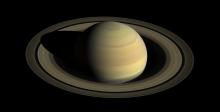Listen to today's episode of StarDate on the web the same day it airs in high-quality streaming audio without any extra ads or announcements. Choose a $8 one-month pass, or listen every day for a year for just $30.
You are here
Autumn
It’s been a scorching summer for much of the country. And while we can’t say whether the scorching is over, we can say that summer is. Autumn arrives in the northern hemisphere today at 3:02 p.m. Central Time — the autumnal equinox.
The season changes when the Sun crosses the equator from north to south. It will continue its southward trek until the winter solstice, in December. As it does so, the days will get ever shorter in the northern hemisphere, while they get longer in the southern hemisphere.
For a few days around the equinox, day and night are about the same length. In fact, that’s where the name “equinox” comes from. It’s a Latin word that means “equal nights.” So at the equinoxes, the interval between sunrise and sunset is roughly 12 hours. And that’s the case across the whole planet.
On the equinox itself, though, the interval is actually a few minutes longer. There are several reasons for that. One is that Earth’s atmosphere acts like a lens, “bending” the Sun’s rays back over the horizon. So when you see the Sun sitting on the horizon, it’s an illusion. The Sun itself is below the horizon, but an image of it is projected back into view.
With the Sun in view for less time each day, and the sunshine coming in at a lower angle, temperatures north of the equator will fall. That will bring more comfortable days after a long, hot summer — and provide more time for watching the stars under the cool nights of autumn.
Script by Damond Benningfield






